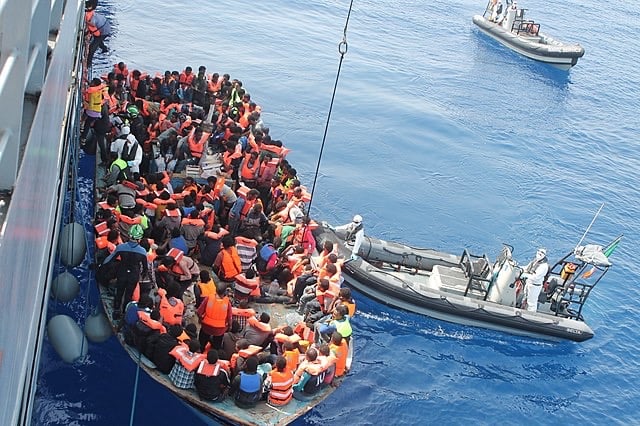More than 1,100 small boat migrants have crossed the English Channel illegally since the new UK-France partial returns deal came into operation last week, with 716 arrivals recorded over the weekend alone.
The latest arrivals made it to Dover harbour on the Border Force vessel Hurricane just before 6pm on Sunday, with Home Office figures confirming that 435 migrants crossed in seven inflatable rafts on Saturday. The weekend surge brings the total number of arrivals since the returns deal was operationalised last Wednesday to 1,119.
So far this year, 26,556 small boat migrants have made the illegal voyage across the Channel, putting 2025 nearly 9,000 ahead of the 17,638 who had arrived at the same point last year. The figures represent a significant acceleration in crossings, with arrivals up approximately 50 per cent compared to 2024.
Maritime sources have warned that weather conditions in the English Channel are expected to remain favourable for most of the week ahead, with one source predicting at least an additional 1,000 crossings by mid-week. The calm conditions typically seen during summer months facilitate more frequent and larger-scale crossing attempts.
The surge in arrivals comes despite the implementation of the groundbreaking “one in, one out” pilot scheme, which saw its first detentions on Wednesday as migrants arrived at Dover’s Western Jet Foil facility. Under the new treaty, migrants who cross the Channel illegally can be detained immediately upon arrival and returned to France, whilst an equal number of asylum seekers with family connections to the UK will be admitted through a new legal route.
Home Secretary Yvette Cooper announced on Thursday that the first group of arrivals had been detained and would be held in immigration removal centres until their return to France. That sends a message to every migrant currently thinking of paying organised crime gangs to go to the UK that they will be risking their lives and throwing away their money if they get into a small boat,” she said.
Footage released by the Home Office showed detained migrants arriving at Western Jet Foil for medical assessment, before being transported to the Manston processing centre. The men were shown wearing dark grey tracksuit jumpers and bottoms whilst being screened by Border Force officers.
The returns agreement, announced during French President Emmanuel Macron’s state visit to the UK in July, marks the first time migrants will be sent back across the Channel since the small boats crisis began. The pilot scheme will remain in force until June 2026, with both countries committed to reviewing and improving the process throughout the trial period.
Under the scheme’s provisions, the Home Office must refer those being returned to French authorities within three days, with France expected to respond within two weeks. Anyone who arrives by small boat and is returned to France will be permanently barred from the legal route to the UK, whilst those who attempt re-entry will be prioritised for immediate return.
The reciprocal element began on Thursday, with migrants in France able to submit expressions of interest for the new legal route. Applicants must provide identity documents, undergo biometric checks, and prove family connections to the UK. The scheme explicitly excludes anyone who has previously attempted an illegal crossing.
Critics have questioned the scheme’s effectiveness given the limited numbers involved. During the initial pilot phase, reports suggest the UK will return approximately 50 migrants per week to France, with an annual cap of 2,600 returns. This represents a fraction of the total arrivals, leading to concerns about the deterrent effect.
The Home Secretary has acknowledged the accord is not a “silver bullet” to stop small boat crossings but represents a “step change” in cross-Channel cooperation. Ministers have rejected criticism that the returns deal leaves open loopholes for human rights challenges to prevent deportations.
The government has prepared for potential legal challenges, learning lessons from the lengthy court battles that derailed the previous Conservative government’s Rwanda deportation scheme. Immigration Enforcement has allocated dedicated space at removal centres, whilst Border Force has developed operational strategies to identify and process inadmissible migrants.
Alongside the returns deal, the government has intensified efforts to tackle illegal working. Since coming to power, Immigration Enforcement has increased activity by 51 per cent, with 10,031 visits leading to 7,130 arrests. A major nationwide enforcement operation targeting illegal working hotspots in the gig economy is planned, with new biometric kits being rolled out for on-the-spot identity checks.
The dramatic increase in crossings this year has placed renewed pressure on processing facilities and accommodation centres. The 2025 figures already exceed many previous years‘ totals, with several months of peak crossing season remaining.
Maritime security experts note that smuggling gangs have become increasingly sophisticated, adapting their tactics in response to enforcement measures. The calm summer conditions have enabled larger boats carrying more migrants, whilst improved coordination between smuggling networks has increased the frequency of departures from French beaches.
As the pilot scheme enters its second week, both governments face scrutiny over whether the limited returns will provide sufficient deterrent effect against the backdrop of record crossing numbers. The coming days will prove critical in determining whether the new approach can begin to reverse the upward trend in Channel crossings.
Follow for more updates on Britannia Daily



